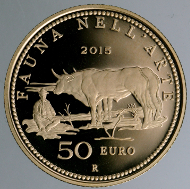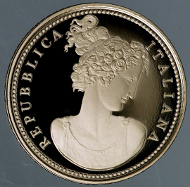May 14, 2015 – The Italian Mint has issued two new Gold Coins, a 50 euro coin in its “Fauna in Art” series and a 20 euro coin in its “Flora in Art” series. The coins show masterpieces of the Italian Rococo (Fauna in Art) and Italian Neoclassicism (Flora in Art):
From Rococo to Macchiaioli – Fauna in Art Series
Rococo is a style of architecture and decoration originating in France in the 18th century as an evolution of Baroque. Characterised by a triumph of decoration, Rococo successfully combined the delicacy of composition with the brilliance of colours. The Macchiaioli, a group of Italian artists active in Tuscany in the second half of the 19th century, privilege an anti-academic pictorial style pursuing Verismo ideals and abolishing the use of geometric lines and dots to emphasise chiaroscuro and spots of colour or “macchie” in Italian, hence the name.
Italy / 2015 / 50 euro / Gold .900 / 16,129 g / 28 mm / Proof / Designer: Annalisa Masini / Mintage: 900.
On the obverse of the coin are two of the dogs that savaged Atteone who had been turned into a deer. It is a detail from one of the two sculptural groups of the Fountain of Diana and Atteone in the Park of the Royal Palace of Caserta created by Paolo Persico, Pietro Solari and Angelo Brunelli and considered an example of Neapolitan Rococo; below, name of the designer “A. MASINI”; around, inscription “REPUBBLICA ITALIANA” and dot decorated frame.
On the reverse of the coin is a rural scenery with a pair of oxen in front of a peasant seating on the floor, a detail from the painting The Rest by Giovanni Fattori (1825-1908) displayed at the Pinacoteca di Brera in Milan; above, the year of issue “2015”; below, the value “50 EURO” followed by the letter “R” identifying the Mint of Rome; above, archshaped inscription ”FAUNA NELL’ARTE”; around, dot decorated frame.
Neoclassicism – Flora in Art Series
Flourished between the second half of 18th century and the first thirty years of the 19th century, Neoclassicism is a European cultural movement characterised by a return to classical forms which was inspired by the aesthetic ideals of the Greek, as well as Roman and Egyptian culture. Neoclassicism affected all aspects of art thus contributing to a deep social and cultural renewal and representing a trait-d’union between Enlightenment and Romanticism.
Italy / 2015 / 20 euro / Gold .900 / 6,451 g / 21 mm / Proof / Designer: Valerio De Seta / Mintage: 1,200.
The coin shows on the obverse a bust of Flora in front view with light drapery, head in profile reclined to the right and crowned with roses; it is a wax model for a cameo created by Benedetto Pistrucci (1784-1855) conserved in the Museo della Zecca of Rome; around, the inscription “REPUBBLICA ITALIANA” and a dot decorated frame.
On the reverse Diana is bathing between two nymphs in a scenery with rocks and a tree; it is a detail from the wax model Diana and Atteone by Benedetto Pistrucci conserved in the Museo della Zecca of Rome; on the left, the year of the coin’s issue “2015” and the value “20 EURO”; below, name of the designer “V. DE SETA” and the letter “R” identifying the Mint of Rome; around, inscription “FLORA NELL’ARTE” and dot decorated frame.
To get to website of the Italian Mint please click here.
To learn more about Rococo and Neoclassicism you may take a look at these style guides provided by the Victoria and Albert Museum:
Style Guide Rococo
Style Guide Neoclassicism








